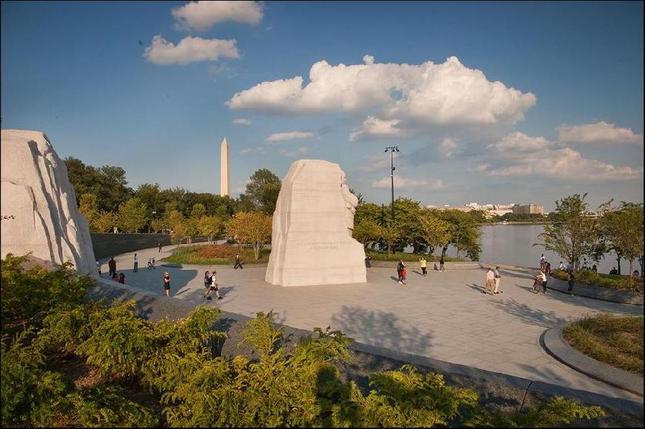Where would our social calendars be without weather dates? A little thing like a history-making-earthquake-and-hurricane combination wasn’t about to shake up D.C. schedules…at least not too much. When the ground shook the district, Virginia and Maryland in August right before Hurricane Irene attacked the East Coast, several things had to be rescheduled, including the dedication of Dr. Martin Luther King, Jr.’s memorial on the National Mall. But in true Washingtonian fashion, the city simply shrugged, sent workers to deal with the boo-boos on the Washington Monument and the National Cathedral, and carried on with plans to dedicate the new civil rights site.
The long-awaited event was originally planned for Aug. 28, which was the 48th anniversary of MLK’s “I Have a Dream” speech. President Obama was scheduled to speak and the country was eager to see the finished product – a massive undertaking of fundraising and design nearly three decades in the making.
Luckily, as the hurricane flooded the streets and toppled trees on that crucial date, another vital anniversary was waiting around the corner as a backup date for the dedication. Oct. 16 marked the Million Man March, held in 1995 on the National Mall to gather the country’s black men in a show of collective voice. Since the memorial is the first one on the mall representing someone of color, choosing a Civil Rights-specific date was crucial.
Standing proudly at the ceremony on Oct. 16 was landscape architect Sheila Brady. A principal at Oehme van Sweden, Brady was a key element in choosing the oaks, pines, magnolias and cherries that surround the newly-dedicated monument. Though many projects are clamoring for the mark of an Oehme van Sweden architect, Brady says she’s the lucky one.
“It’s been a great honor,” she says. “It’s about five years now that we’ve been working on it. The crowd is so inspired and thrilled.” When ROMA, a design group based out of San Francisco, won the competition for the MLK Memorial site, Oehme van Sweden was asked to implement the ideas for the landscape. Brady came on as a director during the development stage. “So we took ROMA’s ideas and visions, respected and honored them, and designed a plan that was fitting for the memorial,” says Brady.
The 30-foot-tall granite statue of Dr. King is imposing and serious. Arms crossed and holding a purposeful look on his face, MLK appears to be waiting for the next step. Those standing before it instantly have a sense of duty: to continue working toward total equality, justice and peace. Just in case the mission isn’t clear enough, King’s most famous quotes are inscribed around him. “There’s so much emotion and honor there and it’s inspiring,” says Brady. “The rest of the mall structures are presidents and war memorials so this is a whole new message for people who visit D.C.”
Though born in New York, Brady has been a Washingtonian for most of her life, tapped well into the socially-conscious heartbeat of the capitol city. Her family set up house inside the beltway in Bethesda when she was 13. Interested in art and design early on in her life, Brady attended and graduated from George Washington University and the Corcoran School of Art and Design. Having developed an interest in traditional architecture, she started to attend exhibits and showcases. That was how she found the work of Dan Kiley. “I was fascinated with this group of plants that he assembled,” she says. “That was the first time I heard the term ‘landscape architect.’” That was the day the tide turned on Brady’s future. “Right there, I was sold. I went into landscaping and I haven’t looked back since.” With her new thirst for natural design, Brady went on to Harvard for a masters in design and eventually found her way to Oehme van Sweden.
At the time, the well-respected D.C. firm had been around for 15 years, founded by Wolfgang Oehme and James van Sweden. For anyone familiar with the art of landscape design, both men are well-known as pioneers of the “New American Garden” style of landscape architecture. Rather than confining the foliage to structured shapes and precise spots, the “New American Garden” is meant to showcase the natural form of the plant, allowing it to grow slightly wild and choose its own path. But rather than acting as an antithesis to more orderly designs, the look is meant to act as a compliment; soft edges against the hard.
Now, after 25 years with the firm and securing a spot as a design principal, Brady has an impressive portfolio of her own. But despite the pedigree, she’s hard-pressed to come up with any favorites in her distinguished career.
“They’ve all been such great projects, from start to finish,” she says. After a few moments of reflection, she admits that the 40-acre botanical garden in Roth, New York was a priceless lesson in serenity and public service for her. “We had this chance to educate the public on literally thousands of different plants,” she says. “That was really special for me.” She’s also partial to memorials, like the MLK project and the World War II structure, another collaboration with ROMA. “You’re on this sacred ground of the monument’s core,” she says. “It’s a reminder that you’re working in orchestration with memory. It was an experience of a lifetime.”
As for the MLK memorial, she says the selected trees and plants were chosen to create a lasting, year-round impact. For instance: “the American Elm variety we chose is called the Princeton Elm and it’s resistant to Dutch Elm disease,” she says. “So that’s kind of symbolic of the memorial’s message. And the ground plane is this wonderful evergreen. So it’s going to be beautiful and strong in all types of weather and conditions.” Overall, the memorial’s green design was concocted to inspire reactions from generations to come. Brady says the plants, the statue and the general design of the memorial are all a testament to things in life that simply won’t be shaken by adversity. “It’s made to endure millions of visitors. It all works together to become a unified, beautiful site.”




